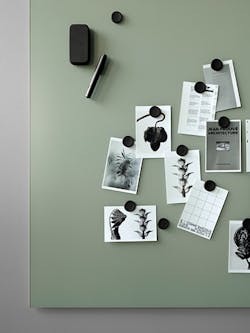Chalkboards aren’t just for schools anymore!
While it may be old news about the temporary signage craze that has found its way into retail and hospitality, the wide array of colors and options—both in chalkboard paint and other signage systems—gives cafes, restaurants, and stores the ability to use temporary signage in unique branding strategies.
► An Analog Solution in a Digital World
There are many useful ways in which the temporary signage trend can be utilized in a project. In particular, they benefit:
- Spaces with limited leases
- Companies with an ever-changing list of offerings
- Shabby-chic interiors
- Historical locales or places that are trying to mimic historical styles
- Instagramable walls
How we’ve seen this trend used:
Spaces with Limited Leases
According to Austin Tenant Advisor’s Nathan Smith, the average lease length is typically 3-5 years. A long-term lease, which many landlords push for, are becoming less and less common as a market in flux leaves company owners more wary of being stuck in a space for 10 years.
These days, restaurants, cafes, and boutique stores are more likely to utilize short-term leases 3 or less years. Everyone has in mind an example of walking by a store to find it was replaced by a new company with little fan-fare.
Since the Recession, short-term leases have become the norm. Because of the cost and time committed to permanent signage is less attractive to those who may only be in a space for a couple of years, temporary signage provides alternative means of displaying a company name or other information.
Companies with an Ever-Changing List of Offerings
Signage can be expensive to switch out, and for eco-conscious companies, the idea of printing out new listings on a regular basis is a no-go.
In particular, the restaurant industry has embraced temporary signage to showcase specialties, drink offerings, and more.
On the island of Lonna in Helsinki, Finland, is a quaint, 60-seat restaurant where premium seasonal dishes are made throughout the summer.
Using mostly Finnish ingredients and locally grown and raised vegetables and protein, Lonna uses a black board to showcase where their current selection of fish are caught. The handwritten board and drawing of the small island adds charm to the space while allowing them to update as needed,
Shabby-Chic Interiors
These days, shabby-chic is in. Interiors are increasingly decorated with found objects, trinkets, and a worn aesthetic.
Temporary signage is integral to the shabby-chic look because of its ability to fit into an urban or country theme. (Who hasn’t seen Pinterest-worthy chalkboards displayed at outdoor or barn weddings?)
Oaklandish, a Bay Area-local store which began as a t-shirt stand at Oakland, California’s farmers market, is a quickly growing apparel company. With five stores in Oakland and Emeryville, including the associated brands BOSK and Oakland Supply Co., the brand specializes in displaying the unique urban flavor of the east bay city.
What’s more, they are political and social advocates. Cut-to-fit large-scale posters display information such as the sexuality and race of their employees and local nonprofits they work with in bright graphics. Rather than pay to have this information painted on the wall or the cost for decals, the poster board display allows Oaklandish to display signage in graphics that fit into the urban environment that can be easily replaced when needed. The graphics are surrounded by local flyers stapled to the board like a community service corkboard or telephone pole, announcing upcoming performances, events, and more.
Historical Locales or Styles
For most of history, digital technology didn’t exist for creating signage. When upgrading a historical space or creating an interior that echoes a historical style, it’s important to stick to more traditional methods of signage.
In The Pantry in downtown Los Angeles, the owners have been painstaking about keeping the signage looking as it had when it originally opened in 1924. The cozy diner doesn’t have menus; instead, patrons for the last nine decades have looked over the soda bar to see the restaurant’s offerings.
However, while most of the interior hasn’t changed since the diner opened, over the years the signage has undergone some changes. The reason, explained The Pantry’s previous manager David Wall, was because the ideas patrons have of historical styles doesn’t match the reality. In the early 20th century, the signage was painted in a variety of sizes, colors, and typography. For the last few changes to the signage, renowned sign artist Bob Behounek has been tasked with creating the handlettering for the menu boards which can be taken down and replaced over time.
2,000 miles away in Iowa City, Iowa, the Graduate Hotel’s Poindexter Coffee takes its theme from the 1970s. A letterboard behind the baristas lets visitors know what’s on the menu against an almost-lime-green wall.
The allure of temporary signage that mimics what used to be is in the nostalgia, said Behounek in an interview. “The restaurants … use hand-lettered signs, and it gives an emotional feel. [The Potbelly chain] hired people all over the country to hand-paint their signs, so the restaurant looked emotional; you had an attachment when you walked in there. So, lettering went from mainstream to specialty because people understood that this type of artwork can draw people into your establishment because of how it looks. It’s not totally perfect—it may be off a bit here and there.”
Instagramable Walls
Of all the ways social media has changed American society, probably the one with the biggest impact on commercial interiors is the idea of an “Instagramable wall”: a wall or place within an interior that is the perfect background for visitors to pose for “selfies.”
As ridiculous as it may seem, building owners are beginning to get onboard with the free advertising that can be generated by patrons social media posts in these spots.
One thing to keep in mind, however, is that—like everything having to do with social media—the allure of a particular spot can fade quickly. Users typically look for never-before-seen backdrops if they aren’t in a famous and instantly recognizable place. What could have been achieved through a well-lit accent wall with a cool wallcovering now needs to be updated on a regular basis.
Temporary signage achieves this perfectly. Using chalk boards, magnetic wallcoverings, and more, backdrops can be switched out as needed.
During NeoCon 2018, interiors+sources’ own Materials Pavilion had a massive Lite-Bright surface which let users rearrange the colorful acrylic pegs to create their own temporary masterpiece for the perfect Instagram shot.
Now Get the Look...
About the Author

Kadie Yale
Former Editor-in-Chief
Kadie Yale holds a BA in Industrial Design from San Francisco State University and a MA in Decorative Art History and Theory from Parsons the New School. In her role as editor-in-chief from 2015-2018, she led the interiors+sources team in creating relevant content that touches on sustainability, universal design, science, and the role of design in society.
